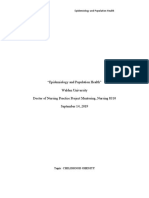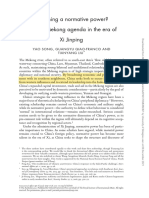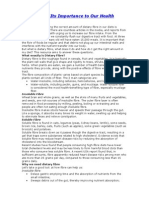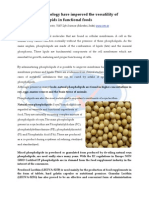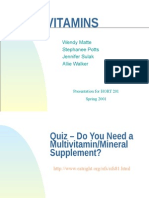0 ratings0% found this document useful (0 votes)
86 viewsVitamins and Minerals
Vitamins and Minerals
Uploaded by
nuradinman89Vitamins and minerals are micronutrients that are essential for the body's proper functioning. They are divided into two classes - water-soluble vitamins like vitamin C and B vitamins, and fat-soluble vitamins like vitamins A, D, E and K. Important minerals include calcium, phosphorus, magnesium, sodium, potassium, chloride, and trace minerals like iron and zinc. Dietary deficiencies can occur due to inadequate intake, absorption issues, or increased requirements during periods like pregnancy. Deficiencies cause characteristic diseases and are a major public health concern.
Copyright:
© All Rights Reserved
Available Formats
Download as PPTX, PDF, TXT or read online from Scribd
Vitamins and Minerals
Vitamins and Minerals
Uploaded by
nuradinman890 ratings0% found this document useful (0 votes)
86 views9 pagesVitamins and minerals are micronutrients that are essential for the body's proper functioning. They are divided into two classes - water-soluble vitamins like vitamin C and B vitamins, and fat-soluble vitamins like vitamins A, D, E and K. Important minerals include calcium, phosphorus, magnesium, sodium, potassium, chloride, and trace minerals like iron and zinc. Dietary deficiencies can occur due to inadequate intake, absorption issues, or increased requirements during periods like pregnancy. Deficiencies cause characteristic diseases and are a major public health concern.
Original Title
vitamins and minerals ppt
Copyright
© © All Rights Reserved
Available Formats
PPTX, PDF, TXT or read online from Scribd
Share this document
Did you find this document useful?
Is this content inappropriate?
Vitamins and minerals are micronutrients that are essential for the body's proper functioning. They are divided into two classes - water-soluble vitamins like vitamin C and B vitamins, and fat-soluble vitamins like vitamins A, D, E and K. Important minerals include calcium, phosphorus, magnesium, sodium, potassium, chloride, and trace minerals like iron and zinc. Dietary deficiencies can occur due to inadequate intake, absorption issues, or increased requirements during periods like pregnancy. Deficiencies cause characteristic diseases and are a major public health concern.
Copyright:
© All Rights Reserved
Available Formats
Download as PPTX, PDF, TXT or read online from Scribd
Download as pptx, pdf, or txt
0 ratings0% found this document useful (0 votes)
86 views9 pagesVitamins and Minerals
Vitamins and Minerals
Uploaded by
nuradinman89Vitamins and minerals are micronutrients that are essential for the body's proper functioning. They are divided into two classes - water-soluble vitamins like vitamin C and B vitamins, and fat-soluble vitamins like vitamins A, D, E and K. Important minerals include calcium, phosphorus, magnesium, sodium, potassium, chloride, and trace minerals like iron and zinc. Dietary deficiencies can occur due to inadequate intake, absorption issues, or increased requirements during periods like pregnancy. Deficiencies cause characteristic diseases and are a major public health concern.
Copyright:
© All Rights Reserved
Available Formats
Download as PPTX, PDF, TXT or read online from Scribd
Download as pptx, pdf, or txt
You are on page 1of 9
Vitamins and minerals
Nutrients are grouped into two major classes:
Macronutrients: are nutrients that are needed by the body in large
amounts. Eg., carbohydrates, proteins, and lipids. Those provides
molecules for the structural and metabolic activities of the human body.
Micronutrients: are those needed by the body in minute amounts.
Eg., vitamins and minerals.
Are essential for the body’s proper functioning.
The need for micronutrients depends on the metabolic activities as well
as on the life cycle of an individual.
Even in intrauterine life, the need for micronutrients is essential for the
normal development of the fetus. In particular, vitamin D, iodine, iron,
and folic acid deficiencies could lead to congenital disorders or even
death.
Vitamins and Minerals
The two important classes of micronutrients are …….
Water-Soluble Vitamins
Most of the vitamins can be dissolved in water.
They are difficult to store in the body and get flushed out in urine when
consumed in large quantities.
They play an important role in producing energy.
Since they are not stored in the body, it is important to take them enough
from different food sources.
For instance:-they are precursors of coenzymes: riboflavin, for example, is
required for the synthesis of the flavin coenzymes, niacin for NAD+ and
NADP+, thiamine for thiamine pyrophosphate, pantothenic acid for
coenzyme A, and folic acid for tetrahydrofolate.
Vitamins and Minerals….
Fat-Soluble Vitamins
These vitamins do not dissolve in water.
These are stored in the liver and fatty tissues for future use.
Eg.,Vitamins A, D, E, and K are important fat-soluble vitamins.
They play a major role in the proper functioning of the immune system,
proper bone development, proper vision, and protection of cells from damage.
For instance: Vit A has importance in various other cellular functions,
unrelated to visual process is also being recognized:
Retinal is involved in vision.
Retinoic acid is involved in growth and cellular
differentiation.
Retinol is necessary for the reproductive system.
Cont’d
Macrominerals
These are required in higher amounts as compared to the trace minerals.
For instance:
•Calcium- For the proper structure and function of bones.
•Phosphorus – Cell membrane structure
•Magnesium- Enzyme reactions
•Sodium- Fluid balance and maintenance of blood pressure
•Chloride- Maintains fluid balance and formation of digestive juices.
•Potassium- Nerve impulse transmission and muscle function.
•Sulphur- present in all the living tissues.
Trace Minerals
These are required in very small amounts, but perform various important
functions in our body. Fe, Mn, Cu, Zn, I, F, and Se are some of the important
trace minerals required by the body.
Dietary Vitamin Deficiencies
Inadequate dietary intake due to faulty dietary habits or poverty.
Inadequate intestinal absorption, which may result from various
gastrointestinal disorders, or from biliary obstruction. The latter may lead to
deficiency of the fat-soluble vitamins (A, D, E, and K) since bile is required
for their absorption.
Inadequate utilization by the target tissues may also lead to vitamin
deficiency, even when dietary intake and absorption are normal. This
Causes of inadequate use include:
Lack of transport prot
eins that carry the vitaminsto the peripheral sites where they are utilized.
Defective uptake of the vitamins by the target tissues or impaired
interaction of the (fat-soluble) vitamins with the receptors located on target
tissues and Failure to convert the vitamin precursor(s) to activated
Dietary Vitamin Deficiencies,…
Increased requirements which occur during pregnancy, lactation, growth,
wound healing and convalescence.
In some cases, an increased requirement precipitates a borderline
deficiency into a frank deficiency.
Drug-induced deficiency such as loss of vitamin synthesis in the
gastrointestinal tract due to elimination of the microorganisms by antibiotics.
Eg.,Pyridoxine deficiency develops in patients receiving isoniazid for the
treatment of tuberculosis (isoniazid forms a hydrazone with pyridoxal; the
pyridoxal hydrazone is rapidly excreted in urine, and the vitamin deficiency
results).In general; Absolute or relative deficiencies of individual vitamins
cause characteristic diseases or syndromes, whose symptoms can be
traced to specific metabolic functions of the missing nutrient.
They are a major public health concern, especially for such at-risk groups as
infants, pregnant women, alcoholics and the elderly.
In summary;
In summary;…
Total body content (in moles) of some minerals in adult male of 70kg body
weight
You might also like
- Automotive Handbook 11th Edition ContentsDocument23 pagesAutomotive Handbook 11th Edition Contentschristian050294100% (1)
- Isat L2Document36 pagesIsat L2isaachari46% (13)
- The Ultimate Jump of Vegetarians in Kenya Where by Exploring On The Benefits and The Challenges of A Plant Based LifestylesDocument2 pagesThe Ultimate Jump of Vegetarians in Kenya Where by Exploring On The Benefits and The Challenges of A Plant Based LifestylesJaffar SadikNo ratings yet
- Week 3 Assignment:-Vitamin and Minerals and Water Oh My! by Ram GazmerDocument3 pagesWeek 3 Assignment:-Vitamin and Minerals and Water Oh My! by Ram GazmerramNo ratings yet
- Food Presentation Vitamin BDocument43 pagesFood Presentation Vitamin BSehar Butt100% (1)
- Ebook NutriliteDocument15 pagesEbook Nutrilitecreovation100% (1)
- Child Obesity AssignmentDocument6 pagesChild Obesity AssignmentElonna AnneNo ratings yet
- Nutrition BasicsDocument49 pagesNutrition Basicstoty-berryNo ratings yet
- Ranking - Best Multivitamins in 2018Document7 pagesRanking - Best Multivitamins in 2018JosephVillanuevaNo ratings yet
- Krone Nutra Product ListDocument10 pagesKrone Nutra Product Listneeraj kumarNo ratings yet
- Omega-3 & Omega-6 Fatty AcidDocument6 pagesOmega-3 & Omega-6 Fatty Acidمحمود الموسويNo ratings yet
- FolateDocument18 pagesFolateNauman ShakirNo ratings yet
- Chapter 6 Nutrition (B)Document30 pagesChapter 6 Nutrition (B)Mei QiiNo ratings yet
- Journey of Nutrilite FinalDocument13 pagesJourney of Nutrilite Finalnileshsingh25No ratings yet
- Why NutriliteDocument1 pageWhy NutriliteAbhishek ChauhanNo ratings yet
- Nutrilite Product HandbookDocument33 pagesNutrilite Product HandbookNikhil JainNo ratings yet
- RDA Chart RDA TableDocument4 pagesRDA Chart RDA TableVisshan SpirulinaNo ratings yet
- The Best Multivitamins:: Your Concise Guide To What To Look For, What To AvoidDocument30 pagesThe Best Multivitamins:: Your Concise Guide To What To Look For, What To AvoidMarco BukNo ratings yet
- ProbioticsDocument24 pagesProbioticsAubrey StuecklerNo ratings yet
- (Song and Liu) Becoming A Normative Power? China's Mekong Agenda in The Era of Xi JinpingDocument18 pages(Song and Liu) Becoming A Normative Power? China's Mekong Agenda in The Era of Xi JinpingMateus BilharNo ratings yet
- Nutrilite Concentrated Fruit and VegetablesDocument18 pagesNutrilite Concentrated Fruit and VegetablesAchyut SadotraNo ratings yet
- Truvivity by NutriliteDocument10 pagesTruvivity by Nutriliteโยอันนา ยุนอา แคทเธอรีน เอี่ยมสุวรรณNo ratings yet
- Lesson 10Document13 pagesLesson 10armin509No ratings yet
- Recommendations To Maintain Immune Health in Athletes Walsh 2018Document13 pagesRecommendations To Maintain Immune Health in Athletes Walsh 2018Felipe Ricardo Garavito PeñaNo ratings yet
- Health Seminar PresentationDocument46 pagesHealth Seminar Presentationmr_harshahsNo ratings yet
- 5-Vitamin and MineralsDocument61 pages5-Vitamin and MineralsAnonymous 8hcK7j2UNo ratings yet
- Sports and Nutrition NotesDocument63 pagesSports and Nutrition Notesyaliyow433No ratings yet
- 36 ObesityDocument59 pages36 ObesitySheikNo ratings yet
- Tiens Food Supplements CatalogueDocument26 pagesTiens Food Supplements CatalogueWahyu TriArya Budhi ChrissantyoNo ratings yet
- Vitamin DeficiencyDocument43 pagesVitamin DeficiencyAathi Pathmanathan100% (1)
- Fibre - Its Importance To Our HealthDocument4 pagesFibre - Its Importance To Our HealthAnbRaoNo ratings yet
- 25 PDFDocument5 pages25 PDFLiliana Buendia BarrientosNo ratings yet
- Alcoholism Diet Obesity Diabetes: Fatty LiverDocument5 pagesAlcoholism Diet Obesity Diabetes: Fatty LiverMukul NehwalNo ratings yet
- What Is Biotin?Document2 pagesWhat Is Biotin?GingBro // MathematicalJobNo ratings yet
- NIgella Sativa GlycationDocument7 pagesNIgella Sativa GlycationAhmad AliNo ratings yet
- Candida Yeast Special Report: Presented by Tony Saldin © 2007 Claire Poulton All Rights ReservedDocument8 pagesCandida Yeast Special Report: Presented by Tony Saldin © 2007 Claire Poulton All Rights ReservedvitallywellNo ratings yet
- Natural Herbal Remedies For HydroceleDocument2 pagesNatural Herbal Remedies For HydroceleAlen Clerk100% (1)
- 8 Ways To Boost Your ImmunityDocument13 pages8 Ways To Boost Your ImmunityHindu Ravindra NathNo ratings yet
- Rigvir EbookDocument32 pagesRigvir EbookatidevaNo ratings yet
- Cold and Flu ReliefDocument2 pagesCold and Flu ReliefTheVitaminStore.com100% (1)
- Sea Buckthorn - LaunchDocument26 pagesSea Buckthorn - LaunchShouvik DasNo ratings yet
- Vitamin DeficiencyDocument5 pagesVitamin Deficiencyritika jainNo ratings yet
- ReversAge BrochureDocument2 pagesReversAge BrochureReliv InternationalNo ratings yet
- Vitamin E ReportDocument10 pagesVitamin E ReportGia DelpanNo ratings yet
- How B Vitamins WorkDocument6 pagesHow B Vitamins Workapi-3709951100% (1)
- Medicine NamesDocument782 pagesMedicine NamesasgbalajiNo ratings yet
- Phospholipids For A Healthy LifeDocument3 pagesPhospholipids For A Healthy Lifearun_kedia648No ratings yet
- Benefits of ProbioticsDocument2 pagesBenefits of ProbioticsGeo IuliaNo ratings yet
- Nutrients and Their Functions Part 2Document22 pagesNutrients and Their Functions Part 2Ndolba100% (2)
- VitaminsDocument94 pagesVitaminsFerdauza TupasNo ratings yet
- DNA of The Nutrilite BrandDocument72 pagesDNA of The Nutrilite BrandElizabeth GonzálezNo ratings yet
- APTG English PDFDocument210 pagesAPTG English PDFBiswajit Mansingh0% (1)
- Mineral Metabolism: General FunctionsDocument12 pagesMineral Metabolism: General FunctionsibntauhidNo ratings yet
- Blood Thinning Foods To AvoidDocument2 pagesBlood Thinning Foods To Avoidjayjonbeach100% (1)
- Lowering Your Blood Pressure With DASHDocument6 pagesLowering Your Blood Pressure With DASHerick100% (1)
- Nutrition EducationDocument11 pagesNutrition EducationMeeta BhalotraNo ratings yet
- Sebamed Digital Marketing PlanningDocument24 pagesSebamed Digital Marketing PlanningH. Imon100% (1)
- Ebook VitaminsDocument7 pagesEbook VitaminsRadzNo ratings yet
- Microbioz India, November 2014, Microbiology MagazinesDocument42 pagesMicrobioz India, November 2014, Microbiology MagazinesMICROBIOZ INDIANo ratings yet
- Metadichol: Rheumatoid Arthritis A Case StudyDocument4 pagesMetadichol: Rheumatoid Arthritis A Case StudyDr P.R. RaghavanNo ratings yet
- Install InfoDocument10 pagesInstall InfoSaid IbrahimNo ratings yet
- Carpeta Sala MultiedaDocument10 pagesCarpeta Sala MultiedajsegadeNo ratings yet
- Report On ICT Training 2 - 3 May 2019Document18 pagesReport On ICT Training 2 - 3 May 2019Gangadhar ChaudharyNo ratings yet
- 2nd Q Tle 10 Lesson 10Document16 pages2nd Q Tle 10 Lesson 10rikifoxyyNo ratings yet
- Qualice Solutions - BrochureDocument18 pagesQualice Solutions - Brochurejamil voraNo ratings yet
- Batallon de San PatricioDocument13 pagesBatallon de San PatricioOmar Marín OropezaNo ratings yet
- SAS SignalDocument11 pagesSAS SignalJuju R ShakyaNo ratings yet
- Fire Claims Professional ApproachDocument28 pagesFire Claims Professional ApproachVimal GoyalNo ratings yet
- Story (John Lasseter, 1995), 3D Computer Graphics (CG) Have Replaced The Classical 2D Realist Styling ofDocument16 pagesStory (John Lasseter, 1995), 3D Computer Graphics (CG) Have Replaced The Classical 2D Realist Styling ofkarinabeltramelloNo ratings yet
- Pass SlipDocument2 pagesPass SlipYhielleNo ratings yet
- Controversial Democrat Mayor Under Investigation After Wild TiradesDocument1 pageControversial Democrat Mayor Under Investigation After Wild Tiradesed2870winNo ratings yet
- Changelog-7.0 - Oracle VM VirtualBoxDocument8 pagesChangelog-7.0 - Oracle VM VirtualBoxlisepa5714No ratings yet
- Thinking and Moral ConsiderationsDocument30 pagesThinking and Moral ConsiderationsGiuseppe Ballacci100% (1)
- Download Nutrigenomics Gerald Rimbach ebook All Chapters PDFDocument81 pagesDownload Nutrigenomics Gerald Rimbach ebook All Chapters PDFoyinyeruse94100% (8)
- Math 3u - Estimating DifferenceDocument16 pagesMath 3u - Estimating DifferenceZL TenorioNo ratings yet
- CPT Coding Essentials for Anesthesiology and Pain Management 2021 American Medical Association All Chapters Instant DownloadDocument48 pagesCPT Coding Essentials for Anesthesiology and Pain Management 2021 American Medical Association All Chapters Instant Downloadsalihsanaey6100% (4)
- BScZOOLOGY SYLLABUS 21-22Document92 pagesBScZOOLOGY SYLLABUS 21-22Abinav A DNo ratings yet
- All Interview Questions and AnswersDocument83 pagesAll Interview Questions and Answersshahnaniksha111No ratings yet
- Determine The Flow Velocity and Discharge ?Document11 pagesDetermine The Flow Velocity and Discharge ?Mâkî Wîsê WôñdêNo ratings yet
- Antecedents and Effects of GreenDocument44 pagesAntecedents and Effects of GreenQuỳnh Trang HồNo ratings yet
- Statement of FaithDocument1 pageStatement of Faithapi-328094478No ratings yet
- Myth ActivityDocument3 pagesMyth ActivityMa'am Roma GualbertoNo ratings yet
- Tabla Equivalecias TotalDocument6 pagesTabla Equivalecias TotalGabriel SalazarNo ratings yet
- Bits Zc471 CM Zc471 HHSM Zc471-l1Document30 pagesBits Zc471 CM Zc471 HHSM Zc471-l1mohimran2002No ratings yet
- Nursing ResearchDocument6 pagesNursing ResearchNicole Page100% (1)
- THIS SUPPLIER AGREEMENT Is Entered Into On BetweenDocument4 pagesTHIS SUPPLIER AGREEMENT Is Entered Into On BetweenEdiNo ratings yet
- STS Week 4-5Document10 pagesSTS Week 4-5JOSHUA SEGUERRANo ratings yet
- Narrative Report MILDocument6 pagesNarrative Report MILRhenz MahilumNo ratings yet






